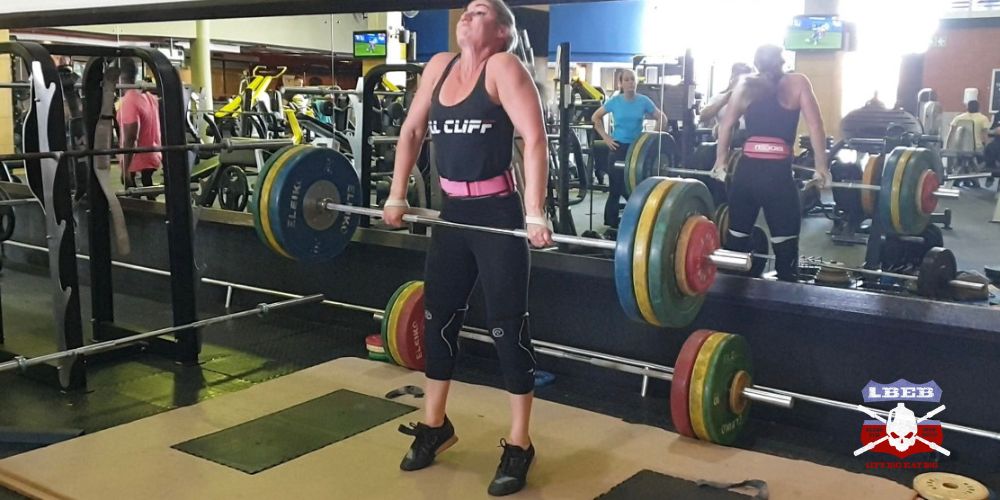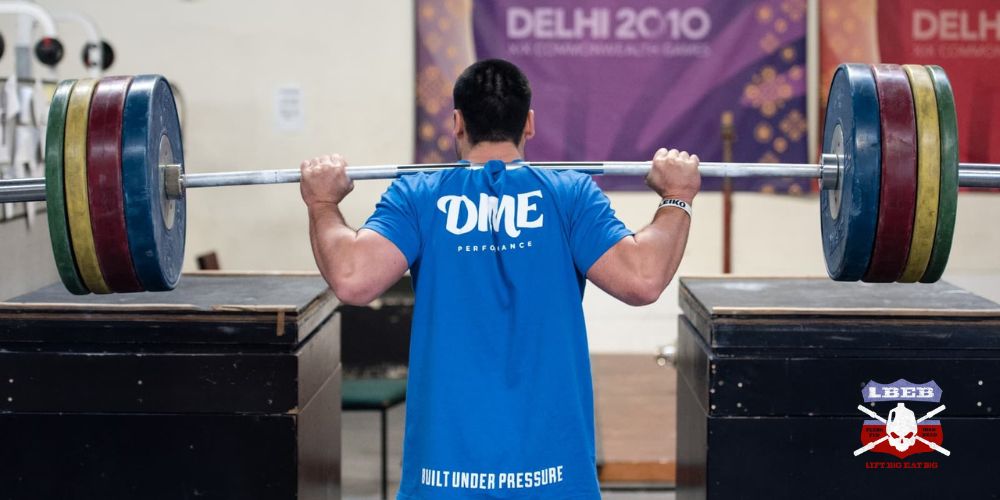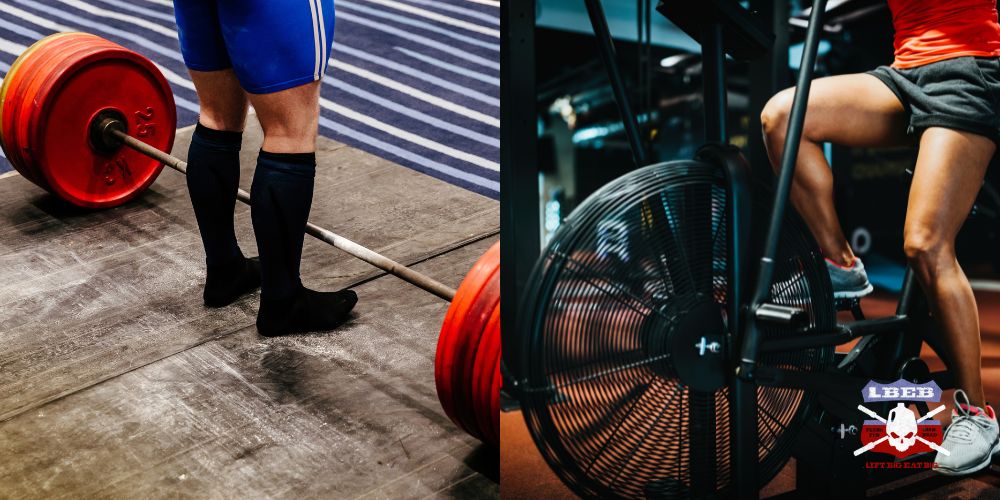CrossFit and Powerlifting attract similar lifters, all of who love the barbell. But CrossFit involves much more than moving a bar up and down and is a more general training system. Powerlifting is specialized to a singular goal. But what’s the main difference?
CrossFit involves high-intensity circuits of various exercises labeled as the sport of functional fitness. On the other hand, Powerlifting involves training exclusively to lift the most weight in the big three lifts; squat, bench press, and deadlift.
There is much more to CrossFit vs. Powerlifting differences that will influence your decision to train.
Table of Contents
What Is CrossFit?
CrossFit is a high-intensity, functional movement fitness regimen combining multiple strength and barbell sports such as Olympic Weightlifting, Powerlifting, Strongman, and gymnastics. Exercises taken from these sports are performed in rapid succession in a circuit format with little rest.
It was initially created to train first responders who must be ready for anything within their job requiring high levels of physical fitness, such as military and police officers [1].
Now CrossFit has become a professional sport headlined by the CrossFit Games, where athletes will specifically train for the sport of CrossFit instead of using it as a training method for work.
But outside of the professional realm, CrossFit gyms welcome people from all walks of life to find community through intense exercise.
Benefits Of CrossFit

Get Fitter
When performing many high-intensity workouts, you’re making cardiovascular health improvements. Pushing to very high intensities when training solo can be challenging, so being part of a planned CrossFit class can help you get there.
Research shows you reach 95-97% of maximum heart rate during popular WODs, similar to high-intensity treadmill running [2].
Movement & Workout Variety
CrossFit is well known for its “randomness.” In some contexts, this is a negative aspect of CrossFit, especially if you’re using it for sports performance. But for general exercise and learning new skills, it’s a great feature other barbell and strength sports won’t give you.
You’ll learn to snatch like a Weightlifter, deadlift like a Powerlifter, carry sandbags like a Strongman, and do muscle-ups like a gymnast. You’ll also spend time running, biking, and performing other calisthenic exercises.
Inclusive Community
The biggest draw to CrossFit is the community. CrossFit leads to a higher sense of community, satisfaction, and motivation than other exercise activities [2]. If you regularly attend class, you’ll build relationships with the people attending as you suffer together.
Suitable For All Levels
From the outside, CrossFit looks advanced. While the highest level involves advanced exercises like handstand walking and muscle-ups, CrossFit can regress exercises. This is known as scaling. Rx workouts are performing workouts of the day (WODs) as is.
Scaling a workout means doing the regressed version. Instead of doing ring muscle-ups, you may do pull-ups. Or band-assisted pull-ups. Snatches may turn to 1-arm DB snatches. There are always options for people of any level.
Get Stronger & Build Muscle
Lifting weights has the positive benefit of building strength and muscle. While CrossFit is optimal for maximizing strength and muscle, you will make improvements as you get better at it. Many CrossFit classes incorporate a strength-focused portion at the beginning to build the skill of strength with a certain exercise.
The high-rep bodyweight movements later in the workout will give you the volume to build muscle.
What Is Powerlifting?
Powerlifting is a sport of sheer strength, competing on the most weight lifted with the big three lifts: squat, bench press, and deadlift. Competitors will dedicate their entire training to increasing their one rep max for these exercises.
Typically, these exercises are performed slightly differently than the regular gym goer to maximize the weight lifted. For example, the squat is performed with a low bar position to involve more hips. The bench press is performed with a bigger arch to shorten the distance the bar travels.
And the deadlift is performed sumo or conventional depending on body proportions. Further, there are many Powerlifting federations with different equipment rules. Some are raw federations, meaning no assistive gear other than belt and knee sleeves can be used.
Others support geared Powerlifting, where squat, bench, and deadlift suits are worn to lift the most weight.
However, the Powerlifts aren’t reserved for competitors. The big three are commonly used in athletic and general strength training populations.
Benefits Of Powerlifting

Increased Bone Density
There’s a reason older adults are encouraged to strength train. Heavy loading prevents osteoporosis as we age by increasing bone density [3][4]. This will reduce your risk of breaking bones when falling or performing athletic tasks.
Dedicated Strength Training
CrossFit is excellent for developing multiple qualities. But Powerlifting is geared solely towards getting stronger on three lifts. It’s what makes Powerlifters some of the strongest athletes on the planet.
Build Muscle
Lifting builds muscle. And building muscle increases your strength potential. Many Powerlifters aren’t super muscular but can lift a house. But if your goal is to look jacked, supplementing with more bodybuilding-style training will complement your Powerlifting training in the long run.
Focus Towards A Singular Goal
Is your primary goal to be as strong as possible? That is the entire premise behind Powerlifting. Training toward a goal gives you a singular focus making it easier to make decisions throughout your week to be conducive to training.
Should you do this crazy CrossFit WOD on the weekend? Probably not if you have a big squat day the next day.
CrossFit vs. Powerlifting: Which Is Better?

Building Muscle
Powerlifting is better than CrossFit for building muscle. Muscle is built lifting with a high relative effort close to failure and progressively adding load. Powerlifting provides a systematic manner within its programming to achieve this.
On the other hand, CrossFit is a smorgasbord of lifting and cardio exercises which little to no focus on building muscle. And this muscle-building stimulus is often blunted by the randomness of workouts.
Getting Fit
CrossFit delivers better cardiovascular gains than Powerlifting. CrossFit involves high-intensity circuits done in every class or session. Powerlifting has little to no cardio requirements, so the most cardio a Powerlifter will do is high-rep lifting sets.
Fat Loss
CrossFit will accelerate rapid fat loss, especially if you’re coming from a sedentary background. The high-intensity and prolonged elevated heart rate burns many calories, quickly placing you in a caloric deficit.
Powerlifters typically only want to lose body fat if moving to a lower weight class. The extra bulk helps lifters feel secure and stronger under the barbell.
Athletic Development
Powerlifting long-term without performing consistent athletic activity kills athletic development. The lack of movement variety and hyper fixation on maximal strength skews physiological adaptations toward improving the ability to lift maximal weights.
Unfortunately, these adaptations oppose those needed for athletic development that involve speed and coordinative tasks. CrossFit is a better option for athletic development because of its exercise variety and the range of qualities it trains.
However, I wouldn’t use either sport for athletic development if you train for a specific sport. You need a program designed specifically for the sport.
Injuries
CrossFit has injury rates of 0.74 to 3.3 per 1000 participation hours, while Powerlifting is between 1 to 5.5 per 1000 hours [5][6]. So, both sports have relatively similar injury rates, especially when taken to a high level.
Done recreationally, CrossFit likely has a higher injury rate because of the wider variety of movements and uses a high-intensity circuit format.
Cost
CrossFit is well-known for its expensive gym fees. You can pay>$300 monthly to attend CrossFit classes. Powerlifting can be trained in any commercial gym or join a Powerlifting club for a much cheaper fee.
While both sports can be done without coaches, having a coach is better. Your primary expense as a Powerlifter will be your programming and coaching, which can cost you approximately $150/month.
Space & Equipment
Powerlifting is a strength sport requiring minimal equipment. A high-quality barbell, iron plates, a bench, and a power rack are your essential pieces of equipment. It can even be done effectively in a single-car garage.
On the other hand, CrossFit requires rig setups, medicine balls, Olympic bars, bumper plates, kettlebells, and more equipment. It also requires enough space to drag sleds, run, and hold cardio machines.
Community
Both sports have a strong community. However, Powerlifting can be a lonely solo sport, depending on how and where you train. CrossFit is known for a strong sense of community, and surveys suggest CrossFit leads to a higher sense of community, satisfaction, and motivation than other exercise activities [7].
Is CrossFit Harder Than Powerlifting?
CrossFit is harder than Powerlifting in the sense of prolonged high-intensity efforts. Powerlifting is challenging in a different way when straining against heavy loads. But most people will find CrossFit is significantly harder because of the technical movements with high-intensity training.
Is CrossFit Good For Powerlifting?
CrossFit is horrible for Powerlifting, and you should avoid it if you have competitive aspirations. CrossFit can add variety to your training if you’re a recreational Powerlifter. But you’re significantly hampering your Powerlifting progress by doing CrossFit.
Summary
CrossFit and Powerlifting are two sports that don’t go well together. You’ll have to choose one or the other if you have competitive aspirations. CrossFit is a better option if you’re after an activity for general health and fitness.
If you want to get as strong as possible in the big three lifts, opt for Powerlifting. You’ll have a better community aspect with CrossFit, however.
References
1. Meyer, J., Morrison, J., & Zuniga, J. (2017). The benefits and risks of CrossFit: a systematic review. Workplace health & safety, 65(12), 612-618.
2. Claudino, J. G., Gabbett, T. J., Bourgeois, F., Souza, H. D. S., Miranda, R. C., Mezêncio, B., … & Serrão, J. C. (2018). CrossFit overview: systematic review and meta-analysis. Sports medicine-open, 4(1), 1-14.
3. Layne, J. E., & Nelson, M. E. (1999). The effects of progressive resistance training on bone density: a review. Medicine and science in sports and exercise, 31(1), 25-30.
4. Bolam, K. A., van Uffelen, J. G., & Taaffe, D. R. (2013). The effect of physical exercise on bone density in middle-aged and older men: a systematic review. Osteoporosis International, 24, 2749-2762.
5. Wagener, S., Hoppe, M. W., Hotfiel, T., Engelhardt, M., Javanmardi, S., Baumgart, C., & Freiwald, J. (2020). CrossFit®–development, benefits, and risks. Sports Orthopaedics and Traumatology, 36(3), 241-249.
6. Siewe, J., Marx, G., Knöll, P., Eysel, P., Zarghooni, K., Graf, M., … & Michael, J. (2014). Injuries and overuse syndromes in competitive and elite bodybuilding. International Journal of sports medicine, 35(11), 943-948.
7. Claudino, J. G., Gabbett, T. J., Bourgeois, F., Souza, H. D. S., Miranda, R. C., Mezêncio, B., … & Serrão, J. C. (2018). CrossFit overview: systematic review and meta-analysis. Sports medicine-open, 4(1), 1-14.
